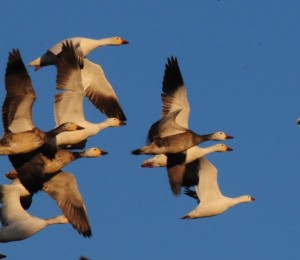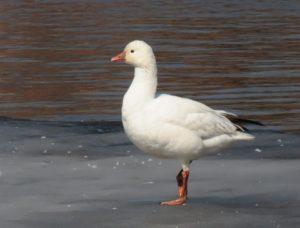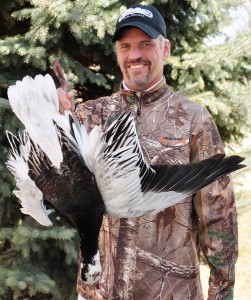Photography courtesy of Lowell Washburn, all rights reserved.
For waterfowl hunting enthusiast, Greg Duesenberg, this year’s spring snow goose season has been as good as it gets. The first big waves of migrating snow geese arrived in Northern Iowa during mid-March, and hunting has remained good since. Success has been so high, in fact, that Duesenberg even managed to bag a goose that was captured and banded four seasons ago on the faraway tundras of Nunavut, Canada. Scarcer than hen’s teeth, banded snow geese are so uncommon that most hunters will never take so much as a single one during an entire lifetime of pursuing the wary white birds.
But just when Duesenberg thought this year’s goose hunt couldn’t possibly get any better; it did. While hunting near Clear Lake last Friday, Greg downed a very unusual, blue phase Ross’ goose. Weighing in at only three pounds, the Ross’ is the smallest goose species to migrate through Iowa each year. Ross’ geese are arctic nesters and, until recently, most birds spent the winter months in California’s Central Valley. But as populations have expanded eastward, Ross’ geese have become an increasingly common sight in Iowa where they are most often seen in the company of migrating lesser snow geese.
Ross’ geese have the same characteristic pink legs and bill, snow white plumage, and jet black wing tips as their larger cousins. Were it not for the size difference, it would be hard for most folks to tell the two apart; especially when on the wing. Although snow geese come in two distinct color phases; white and dark [blue], Ross’ geese do not — Well, at least most of the time they don’t. Like a needle in the haystack, a blue phase Ross’ goose will occasionally pop up. So how unusual is a dark phase Ross’ goose? According to biologists with the U.S. Fish & Wildlife Service, it is “nothing short of the rarest form of waterfowl to be found anywhere on the North American continent”. Less than one dark phase goose occurs for each 100,000 Ross’ observed. Yup, that’s rare. On top of that, most of those dark birds are actually hybrids or partial crosses with snow geese. Duesenberg’s bird, however, is not. All of his bird’s weights, wing, leg, bill and head measurements fall well within the tolerances of a genetically pure Ross’ goose; facts that make the bird even rarer. Duesenberg’s goose can only be described as the ’Trophy of a Lifetime’. Although Greg loves to eat the geese he bags; his blue phase Ross’ goose isn’t headed for the oven. Instead, it’s making its way straight to the taxidermist.




 Tom Cope
Tom Cope Sue Wilkinson
Sue Wilkinson Susan Judkins Josten
Susan Judkins Josten Rudi Roeslein
Rudi Roeslein Elyssa McFarland
Elyssa McFarland Mark Langgin
Mark Langgin Adam Janke
Adam Janke Joe Henry
Joe Henry Kristin Ashenbrenner
Kristin Ashenbrenner Joe Wilkinson
Joe Wilkinson Dr. Tammy Mildenstein
Dr. Tammy Mildenstein Sean McMahon
Sean McMahon